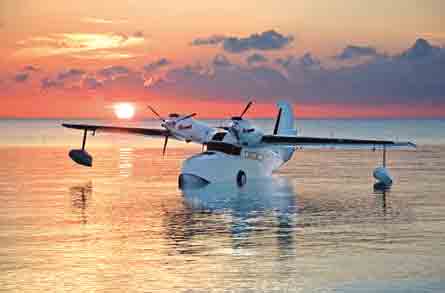Buoyant sector
Seaplane manufacturers and float installers have enjoyed a bumper year, but pilot shortages threaten to hold back growth
Orders are strong for seaplanes and floats as the de Havilland Canada Twin Otter and Grumman Goose are about to re-enter production and float conversions have had a bumper year. However, the pilot shortage that plagues general aviation is holding back seaplane growth that might go even higher.
"We've had our best year ever," says Bob Wiplinger, chairman of Wipaire, which holds STCs to install floats on Cessna, de Havilland Canada, Pilatus, Piper and Air Tractor aircraft.
"The [Cessna] Caravan market has been especially strong on the North American continent, but it's gained a lot in Europe in the last two years. The Twin Otter market is increasing in Europe and the small float single-engine Cessnas have been starting in Europe," he says. "South American countries have just started to look seriously at it."
Operating efficiency of the float-equipped Air Tractor AT-802 has led to a jump in sales for firefighting applications. "This airplane was introduced there about five years ago and it became a very cheap alternative to the Canadair CL 415. It's the only single-engine scooper aircraft available," Wiplinger says. The 802 operates for about 1/30th the cost of flying a 415 and it carries half the water, he adds. "Most sales are in Europe, with some in Canada and the United States. We've got more than 35 aircraft in Europe, mostly in Spain and Portugal, now Croatia and soon to be Italy and France and maybe Turkey."
Generally breaking into new territory is not too hard, says Wiplinger, but "we just finished an EASA certification on a Twin Otter and it was a pretty big ordeal. They decided to audit it." This made the certification a real challenge and helped him decide to keep their new float on the Quest Kodiak and Cessna Grand Caravan away from Europe.

The Grumman G-21 Goose flew all round Europe during the second world war, but production ended with the war and only 60 of the original 345 are airworthy. Now Antilles Seaplanes of North Carolina plans to produce 72 a year, with the first to be delivered in late 2008 or early 2009. "The hard one is number one," says owner VL Manuel.
The company is building the production line from scratch inside a new 1,860m2 (20,000ft2) facility and will offer 680shp (510kW) Pratt&Whitney Canada PT-6A turboprop engines or 450hp P&W R-985 radials on the new G21 G.
Centre of gravity
Order books opened in the first week of December, but Manuel says corporate and government customers are eager to get flying. "It's not a surge in demand. It's been there and it's been served by regular aircraft adapted by floats. But this aircraft was designed for this so it performs better," he says. Since the Goose is a flying boat its centre of gravity is low, he says, letting it take higher waves and handle crosswinds.
"A lot of resorts and places out there in the world you can only reach by floatplane or boat. Developing nations with little infrastructure and no airports, that's how the aircraft came into being. There are lots and lots of those, and their governments are trying to find a way to get their people and their economy moving," Manuel says.
A study by Viking Air shows there is demand for 440 new Twin Otter Series 400s over 10 years. Some 955 DHC-6 Twin Otters were made before Bombardier ended 20 years of production in 1988, and now slots are sold out until 2012.
Source: Flight International
















